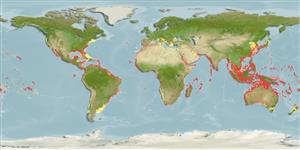Common names from other countries
>
Carangiformes (Jacks) >
Echeneidae (Remoras)
Etymology: Echeneis: Greek, echein = to hold + Greek, nays = ship; remora, suckling fish; 1774 (Ref. 45335).
More on author: Linnaeus.
Environment: milieu / climate zone / kisaran kedalaman / distribution range
Ekologi
laut; payau berasosiasi dengan karang; kisaran kedalaman 1 - 85 m (Ref. 86942). Subtropical; 45°N - 45°S, 180°W - 180°E
Circumtropical.
Size / Weight / umur
Kematangan: Lm ? range ? - ? cm
Max length : 110 cm TL jantan/; (Ref. 9710); common length : 66.0 cm SL jantan/; (Ref. 10970); Berat maksimum terpublikasi: 2.3 kg (Ref. 40637)
Duri punggung (Keseluruhan (total)) : 0; duri punggung lunak (Keseluruhan (total)) : 32 - 42; Duri dubur: 0; Sirip dubur lunak: 29 - 41.
Body shape (shape guide): elongated.
Most abundant remora in warm waters (Ref. 4389). Occurs near as well as far from the coast (Ref. 5217). Often found free-swimming in shallow inshore areas and around coral reefs (Ref. 26938). Attaches temporarily to a variety of hosts including sharks, rays, large bony fishes or sea turtles, whales, dolphins and also to ships. May follow divers (Ref. 9710); reported to attach itself to a diver's leg (Ref. 57809). Feeds on small fishes, bits of its host's prey and host's parasites (Ref. 26938). Juveniles occasionally act as reef station-based cleaners, where they service parrotfishes (Ref. 40095). Sometimes used by natives to aid in fishing; a line is tied to the caudal peduncle of the remora and then is released; upon attaching to another fish, the remora and its host are hauled in by the fisher (Ref. 9682).
Paxton, J.R., D.F. Hoese, G.R. Allen and J.E. Hanley, 1989. Pisces. Petromyzontidae to Carangidae. Zoological Catalogue of Australia, Vol. 7. Australian Government Publishing Service, Canberra, 665 p. (Ref. 7300)
Status IUCN Red List (Ref. 130435: Version 2025-1)
ancaman kepada manusia
Harmless
penggunaan manusia
Perikanan: nilai komersial kecil; Ikan buruan: ya; Akuarium: Komersial
Alat, peralatan
laporan khas
muat turun XML
Sumber internet
Estimates based on models
Preferred temperature (Acuan
123201): 18.3 - 28.6, mean 27.2 °C (based on 566 cells).
Phylogenetic diversity index (Acuan
82804): PD
50 = 0.7539 [Uniqueness, from 0.5 = low to 2.0 = high].
Bayesian length-weight: a=0.00257 (0.00110 - 0.00600), b=3.17 (2.96 - 3.38), in cm total length, based on LWR estimates for this (Sub)family-body shape (Ref.
93245).
Trophic level (Acuan
69278): 3.7 ±0.3 se; based on diet studies.
Daya lenting (Acuan
120179): sedang, Waktu penggandaan populasi minimum 1.4 - 4.4 tahun (Assuming Fec < 10,000).
Fishing Vulnerability (Ref.
59153): High to very high vulnerability (66 of 100).
🛈
Nutrients (Ref.
124155): Calcium = 22.5 [10.7, 37.1] mg/100g; Iron = 0.59 [0.32, 0.99] mg/100g; Protein = 19.8 [18.7, 20.8] %; Omega3 = 0.128 [0.068, 0.250] g/100g; Selenium = 28.3 [13.0, 54.4] μg/100g; VitaminA = 25.8 [8.3, 87.1] μg/100g; Zinc = 0.702 [0.456, 1.085] mg/100g (wet weight);
